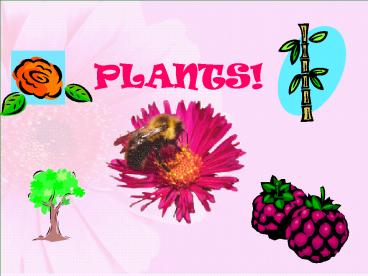PLANTS! - PowerPoint PPT Presentation
1 / 13
Title:
PLANTS!
Description:
PLANTS! * * You can use this powerpoint as a guide through the stations lab, it is not meant as notes, only as discussion. The first three s can be discussed as ... – PowerPoint PPT presentation
Number of Views:330
Avg rating:3.0/5.0
Title: PLANTS!
1
PLANTS!
2
Overview of Plants
- Are plants multicellular or unicellular?
Multicellular
- Eukaryotic or Prokaryotic?
Eukaryotic
- Of what is their cell wall composed?
Cellulose
- How do they obtain nutrition?
Autotrophs
3
Plant Cell Structure
Vacuole
Chloroplast
Cell Wall
Nucleus
4
Plant Evolution
Common Ancestor?
5
Seed/Flowers 130 mya
Seed/Cone 360 mya
Vascular 400 mya Seedless
Nonvascular 550 mya
6
Common Ancestor?
Algae Is it a Plant?
www.alagebase.org - courtesy of Mike Guiry
7
Bryophytes - Nonvascular Plants
- - early land plants, no vascular system.
Without a vascular system, they can not support
roots, stems, and leaves.
Ex. Mosses, liverworts
8
Pteridophytes - Primitive Vascular
- Seedless
- Have vascular tissue
- Can support roots, stems, leaves
- Size varies greatly
- Rely on water for reproduction
- Ex Ferns, club mosses, horsetails
9
Gymnosperms Seed Plants
- Have vascular tissue
- Can support roots, stems, leaves
- Size varies greatly
- Have pollen to reproduce away from water
- Have naked seeds produced in cones
- Ex Redwood, Spruce, Pine
Female Cone
Male (Pollen Cone)
10
Angiosperms Flowering Plants
- Have vascular tissue
- Can support roots, stems, and leaves
- Size varies greatly
- Have pollen to reproduce away from water
- Have flowers to surround and protect the seeds
and to attract pollinators - Most diverse and widespread group of land plants
- Have covered seeds dispersed in fruit
- Ex Rose, cucumber, tomato
11
2 main classes of Angiosperms Monocots and
Dicots
- based on the number of seed leaves (cotyledons)
they produce.
12
Monocots
lilies, orchids, yuccas, grasses, and grains
(65,000 species)
13
Dicots
includes roses, peas, sunflowers, oaks, and maples
(165,000 species)































